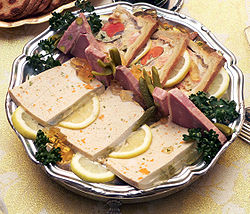Pâté

Pâté (French pronunciation: [pɑte]; RP pronunciation: [ˈpæteɪ]; General American pronunciation [pɑˈteɪ]) is a form of spreadable paste, usually made from meat (although vegetarian variants exist), and often served with toast as a starter. "Pâté" is a French word which designates a mixture of minced meat and fat.
It is generally made from a finely ground or chunky mixture of meats such as liver, and often additional fat, vegetables, herbs, spices, wine and other ingredients.
In French or Belgian cuisine, pâté may be cooked in a crust as pie or loaf, in which case it is called pâté en croûte. On the other hand, it may be cooked in a terrine (or other mold), often lined with fat, in which case it is known as pâté en terrine. Traditionally, a forcemeat mixture cooked and served in a terrine is called a terrine, but when it is unmolded it becomes pâté. It can be cooked as, and in, a terrine, and be called for the vessel, but this has no influence on the end product.
The most famous pâté is probably pâté de foie gras, which is made from the fattened livers of geese. (Note, however, that connoisseurs generally prefer the foie gras entier, which is simply foie gras cooked and sliced, and technically not made into pâté. Also, the bloc de foie gras (trans. from Fr.: "loaf of goose liver") is not technically a type of pâté with respect to French cooking terminology.)
In Holland, Germany and Austria, liver pâté is often made as a cooked sausage, called leverworst (Dutch) or Leberwurst (German). In the United States these are sometimes called "liverwurst" (mixing English and German), or Braunschweiger. Some of these products result in a meat texture which is difficult to smear, and often eaten in chunks or slices. In the US, sliced liverwurst is used as a sandwich filler. These types have become a popular export into Eastern Europe, with significant local production now also taking place. Others are spreadable as is most French or Belgian pâté; these types are more popular in England.
In Scandinavia, leverpostej is a variant of the French pâté en terrine and is made of pork liver. According to Danish popular opinion, it is the most popular cold cut, and commonly eaten on bread.
In Russia and Ukraine, the dish is mostly prepared with liver and thus is commonly known as печеночный паштет (Russian, pechonachniy pashtet), however other meats also can be used. Unlike the Western European method the liver is first boiled and made into a paste with butter (and/or rendered intestinal fat) and seasoning, such as herbs, fresh or fried onion, and so on. It can be further cooked (usually baked), but most often used without other preparations. The pâté is served on top of bread, often with a small dill leaf or other herb on top.
Vegetarian pâtés
Vegetarian pâtés based on mushrooms, nuts or various beans are particularly popular. These pâtés do not require cooking and are easily made with a food processor.[1]
